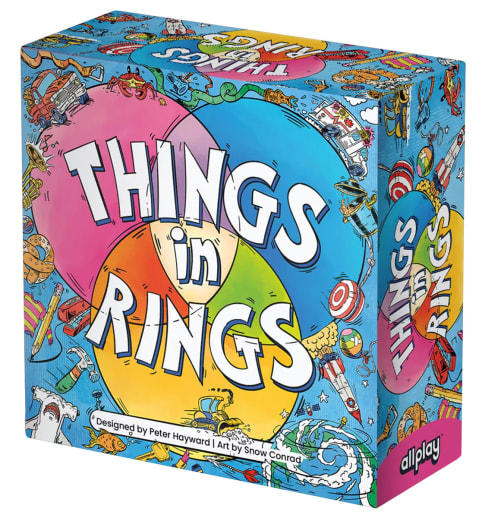From there to here and here to there, things in rings are
everywhere!
In Things in Rings, like in every other game, there are
rules—but when players begin, no one except for the person who plays the role
of the "knower" knows what the rules are! How can anyone play a game like this?
Not only is it possible, but it is fun.
Overview:
In this party game, all players who are not the "knower" are the "finders," who are trying to empty all the cards, which are the things in rings from their
hand. To do this, they must correctly place each card in none, one, two, or all
three rings, based on which cards they believe include none, one, two or all
three of the following rules, which correlate to the colors of the rings:
- Attribute (Blue Ring): An item’s physical properties. This might be a rule regarding color, size, weight, or shape. Examples: contains plastic; weighs more than a chair.
- Word (Yellow Ring): How the item is spelled, pronounced, or how many letters are in it. Examples: has 1 syllable; ends with a consonant or “Y”.
- Context (Red Ring): This rule might describe things like where items in this rule are found, what they are worth, or how old an item or thing that fits this rule is. Examples: you expect to find it in a school; most people see it regularly.
Gameplay:
One, two, or all three rings are placed on the table,
depending on the level of challenge that the players want, which ranges from
easy for one ring, medium for two, and difficult for three. If using two rings,
there should be overlapping areas between them, and if three are used, there
should be an area that overlaps each combination of two rings and another area
where all three overlap. The "knower" is chosen, and that player chooses random
rules cards for each ring that is being used from a subset of rules cards that
have the chosen difficulty level on the back.
There is a “Things” deck, which are objects that will
match none, one, two, or three rules among the hidden, chosen rules for the
game. Each player receives five of these cards. The "knower" chooses three of
their Thing cards that follow the ring rules. These act as clues to help the "finders" start guessing the rules. The "knower" then discards their other two Thing cards.
For the rest of the game, each "finder" takes turns choosing
a card from their hand and placing it face-up anywhere inside or outside the
rings. (The area outside represents no matching rules.) The "knower" looks at their choice and either confirms
it was correctly placed or moves it to the area it belongs if it was not. If
the "finder" was right, they can place another Thing card. If they were not
correct, they must draw another card. When any player has emptied their hand of
Thing cards correctly, they automatically win the game. All players can then
guess the secret rules just to see if they have figured them out!
This fast-paced game encourages deductive reasoning skills as players find common attributes between words. Things in Rings creates conversation, and the complexity can be tailored to the group. The rulebook also contains a variant set of rules for cooperative play. For 2-6 players with a 20+ minute gametime.

